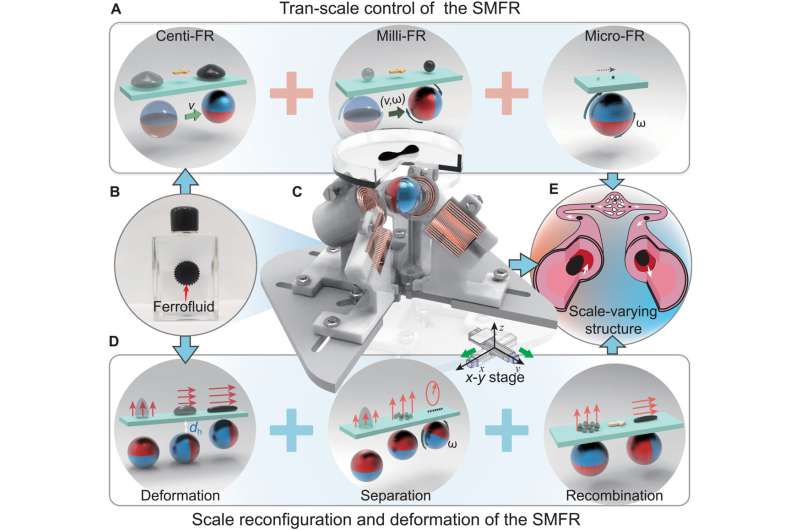September 19, 2022 report
Tiny soft robot can split into tinier bits then reassemble after passage through small spaces

A team of researchers at Soochow University, working with two colleagues from the Max Planck Institute for Intelligent Systems and another from Harbin Institute of Technology has developed a type of soft robot that can be split into tinier components to pass through small spaces and then reassemble. In their paper published in the journal Science Advances, the group describes how they made their tiny robots and suggest possible uses for them.
As the science of robotics continues to mature, engineers around the world continue to find new ways to make them. In this new effort, the researchers made theirs out of a ferrofluid (magnetic iron oxide nanoparticles) that they suspended in a clear oil. The robot is controlled using external magnets.
Using a robot made of a material that is only very loosely held together, the researchers note, allows the alteration of its shape on demand. By applying multiple magnetic fields, they showed that it was possible to direct their robot through a maze, at times changing its shape to overcome obstacles. They forced it to elongate, for example, to squeeze through a narrow passageway. They also broke it into a desired number of smaller parts to pass through a porous material. In both cases, the robot was then easily reassembled into a single round robot shape and continued on with its journey. They note that such a robot could be made in a wide variety of sizes.
The robot could conceivably be used in medical applications as a means for carrying drugs to difficult-to-access body parts, such as lung nodes or parts of the brain. The researchers acknowledge that for practical applications, the design would have to overcome many obstacles, most obviously, the development of a magnetic control system that can accurately penetrate bone such as the skull. In the meantime, others have noted that such a robotic system could prove to be useful in lab-on-a-chip devices where chemical processes are conducted for tasks such as virus detection. The tiny new robots could perhaps be used to carry the chemicals needed for the reactions.
More information: Xinjian Fan et al, Scale-reconfigurable miniature ferrofluidic robots for negotiating sharply variable spaces, Science Advances (2022). DOI: 10.1126/sciadv.abq1677
© 2022 Science X Network


















